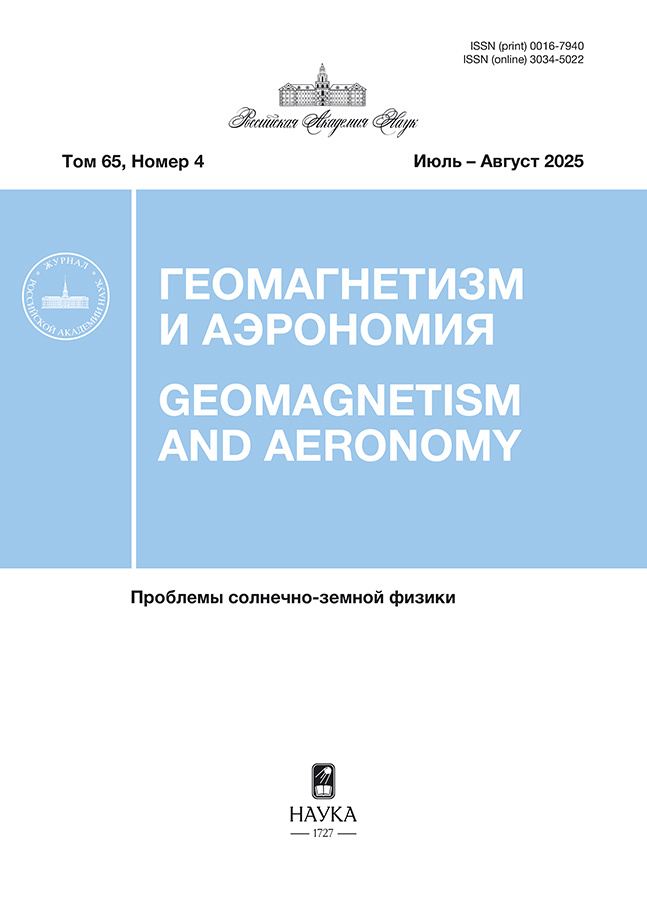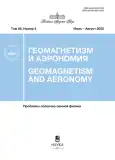Trends in the F2-layer parameters based on the Sverdlovsk (Arti, 56 N) station data
- Authors: Danilov A.D.1, Konstantinova A.V.1, Ryabukhin I.А.2
-
Affiliations:
- Fedorov Institute of Applied Geophysics
- Bulashevich Institute of Geophysics
- Issue: Vol 65, No 4 (2025)
- Pages: 482-499
- Section: Articles
- URL: https://modernonco.orscience.ru/0016-7940/article/view/688301
- DOI: https://doi.org/10.31857/S0016794025040073
- EDN: https://elibrary.ru/EXZLIM
- ID: 688301
Cite item
Abstract
Long-term variations (trends) in two parameters of the ionospheric F2 layer (foF2 and hmF2) based on the observations at the Sverdlovsk (Arti) ionospheric station and the calculated values of TEC over that station are analyzed. Five near-noon moments of LT are considered. Principal analysis is performed for three winter months, but for the sake of comparison, the values of the trends in foF2 and hmF2 for the spring month April, summer month July and fall month October are also presented. A confirmation of the existence of seasonal variations in the foF2 trends is obtained: negative trends are the strongest in winter. The obtained results agree with the results obtained earlier for midlatitude stations of the Northern and Southern hemispheres. No substantial seasonal variations are found for the hmF2 trends. Trends in the ТЕС values over the aforementioned station are also considered. It is demonstrated that there is a reasonable agreement between the relative trends (in percent) in foF2 и ТЕС.
Full Text
About the authors
A. D. Danilov
Fedorov Institute of Applied Geophysics
Author for correspondence.
Email: adanilov99@mail.ru
Russian Federation, Moscow
A. V. Konstantinova
Fedorov Institute of Applied Geophysics
Email: adanilov99@mail.ru
Russian Federation, Moscow
I. А. Ryabukhin
Bulashevich Institute of Geophysics
Email: adanilov99@mail.ru
Hermann and Robert Abels Laboratory–Observatory “Arti”
Russian Federation, Arti, Sverdlovsk oblastReferences
- Данилов А.Д., Бербенева Н.А. Тренды критической частоты слоя F2 в последнее десятилетие // Геомагнетизм и аэрономия. Т. 63. № 2. С. 139–146. 2023. https://doi.org/10.31857/S0016794022600697
- Данилов А.Д., Бербенева Н.А. Зависимость foF2 от индексов солнечной активности по данным ионосферных станций Северного и Южного полушарий // Геомагнетизм и аэрономия. Т. 64. № 2. С. 253–264. 2024. https://doi.org/10.31857/S0016794024020083
- Данилов А.Д., Бербенева Н.А. Тренды параметров области F и их возможные причины // Геомагнетизм и аэрономия. Т. 65. № 3. C. 343–350. 2025.
- Данилов А.Д., Константинова А.В. Вариации трендов foF2 с сезоном и временем суток // Геомагнетизм и аэрономия. Т. 55. № 1. С. 56–63. 2015. https://doi.org/10.7868/S0016794015010046
- Данилов А.Д., Константинова А.В. Долговременные изменения параметра “Дельта foF2” по данным двух европейских ионосферных станций // Геомагнетизм и аэрономия. Т. 57. № 5. С. 623–627. 2017. https://doi.org/10.7868/S0016794017050054
- Данилов А.Д., Константинова А.В. Сравнение трендов различных параметров слоя F2 // Геомагнетизм и аэрономия. Т. 64. № 5. С.723‒724. 2024.
- Данилов А.Д., Константинова А.В., Бербенева Н.А. Дальнейший детальный анализ зависимости foF2 от солнечной активности // Гелиогеофизические исследования. Вып. 40. С. 68–80. 2023а. https://doi.org/10.5425/2304-7380_2023_40_68
- Данилов А.Д., Константинова А.В., Бербенева Н.А. Детальный анализ суточных вариаций трендов foF2 // Гелиогеофизические исследования. Вып. 39. С. 8–16. 2023б https://doi.org/10.5425/2304-7380_2023_39_8
- Данилов А.Д., Константинова А.В., Бербенева Н.А. Тренды критической частоты foF2 по данным станций Северного и Южного полушарий // Геомагнетизм и аэрономия. Т. 64. № 3. С. 387–400. 2024a. https://doi.org/10.31857/S0016794024030059
- Данилов А.Д., Константинова А.В., Бербенева Н.А. Долговременные тренды высоты максимума ионосферного слоя F2 // Геомагнетизм и аэрономия. Т. 64. № 4. С. 489–502. 2024б.
- Данилов А.Д., Константинова А.В., Бербенева Н.А. Изменение со временем соотношения между критической частотой и высотой слоя F2 // Геомагнетизм и аэрономия. Т. 64. № 5. С. 656‒666. 2024в.
- Cnossen I., Emmert J.T. Garcia R.R., Elias A.G., Mlynczak M.G., Zhang Sh.R. A review of global long–term changes in the mesosphere, thermosphere and ionosphere: a starting point for inclusion in (semi–)empirical models // Adv. Space Res. V. 74. № 11. P. 5991–6011. 2024. https://doi.org/10.1016/j.asr.2024.10.005
- Danilov A.D., Berbeneva N.A. Statistical analysis of the critical frequency foF2 dependence on various solar activity indices // Adv. Space Res. V. 72. № 6. P. 2351–2361. 2023. https://doi.org/10.1016/j.asr.2023.05.012
- De Haro Barbás B. F., Elias A. G. Effect of the inclusion of solar cycle 24 in the calculation of foF2 long–term trend for two Japanese ionospheric stations // Pure Appl. Geophys. V. 177. № 2. P. 1071–1078. 2020. https://doi.org/10.1007/s00024-019-02307-z
- De Haro Barbás D.F., Elias A.G., Venchiarutti J.V., Fagre M., Zossi B.S., Jun G.T., Medina F.D. MgII as a solar proxy to filter F2–region ionospheric parameters // Pure Appl. Geophys. V. 178. № 11. P. 4605–4618. 2021. https://doi.org/10.1007/s00024-021-02884-y
- Duran T. Melendi Y., Zossi B.S., de Haro Barbás B.F., Buezas F.S., Alfredo Juan A., Elias A.G. Contribution to ionospheric F2 region long–term trend studies through seasonal and diurnal pattern analysis // Global Planet. Change. V. 229. ID 104249. 2023. https://doi.org/10.1016/j.gloplacha.2023.104249
- Elias A. Alberti T., Bravo M. et al. Long–term trends in the ionospheric equivalent slab thickness: Some evidences by Working Team #1 within IAGA WGII–F / Paper presented at the 12th International Workshop on Long–Term Changes and Trends in the Atmosphere. May 6–10, 2024. Ourense, Galicia, Spain. 2024.
- Laštovička J., Akmaev R.A., Beig G., Bremer J., Emmert J.T., Jacobi C., Jarvis M.J., Nedoluha G., Portnyagin Yu.I., Ulich T. Emerging pattern of global change in the upper atmosphere and ionosphere // Ann. Geophys. V. 26. № 5. P. 1255–1268. 2008. https://doi.org/10.5194/angeo–26–1255–2008
- Laštovička J. Progress in investigating long–term trends in the mesosphere, thermosphere, and ionosphere // Atmos. Chem. Phys. V. 23. № 10. P. 5783–5800. 2023. https://doi.org/10.5194/acp-23-5783-2023
- Laštovička J. Dependence of long–term trends in foF2 at middle latitudes on different solar activity proxies // Adv. Space Res. V. 73. № 1. P. 685−689. 2024. https://doi.org/10.1016/j.asr.2023.09.047
- Laštovička J., Burešová D. Relationships between foF2 and various solar activity proxies // Space Weather. V. 21. № 4. ID e2022SW003359. 2023. https://doi.org/10.1029/2022SW003359
- Urbář J., Laštovička J. Global long–term trends in the total electron content // Preprint EGUsphere. ID 3021. 9 p. 2024. https://doi.org/10.5194/egusphere-2024-3021
- Yue X., Hu L., Wei Y., Wan W., Ning B. Ionospheric trend over Wuhan during 1947–2017: Comparison between simulation and observation // J. Geophys. Res. – Space. V. 123. № 2. P. 1396–1409. 2018. https://doi.org/10.1002/2017JA024675
- Zossi B.S., Medina F.D., Duran T., Elias A.G. The effect of mixing EUV proxies on the correlation with foF2 and on long–term trends estimations // Adv. Space Res. V. 74. № 10. P. 4930–4936. 2024. https://doi.org/10.1016/j.asr.2024.07.064
- Zossi B.S., Medina F.D., Duran T., Elias A.G. Selecting the best solar EUV proxy for long–term timescale applications // Adv. Space Res. V.75. № 1. P. 856–863. 2025. https://doi.org/10.1016/j.asr.2024.07.023
Supplementary files



















